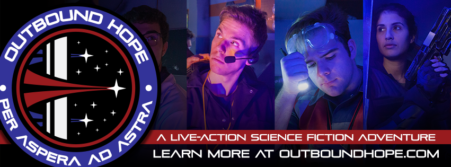
Photos by M. Payne, and used from OutboundHope.com. For more, visit OutboundHope.com.
Mission Overview:
About a month ago I had the absolute joy of participating in Quest Adventure Gaming’s pioneer blockbuster LARP event The Outbound Hope Mission. The game took place in Bay City, Michigan and used the museum battleship of the U.S.S. Edson as our spaceship for the weekend. The game drew heavily on many popular science fiction fandoms including Battlestar Galactica, Star Trek, Stargate and the Honor Harrington novels by David Weber to set the tone of the story and universe.
Outbound Hope: The Plot
In a not too distant future, mankind has developed faster than light travel which led to a new resurgence in colonialism throughout the galaxy. With new colonies sprouting up on Luna (our moon), Mars and several of Jupiter’s moons, we were exploring more of our solar system than ever before. It was during this exploration that a large hexagonal structure was found floating in space, completely regular in its structure but for a small, human-hand sized indentation along the structure’s surface.
After placing a hand against the indentation, the hexagon powered up and became a gateway—now known as The Bifrost. If a ship passed through the middle of the Bifrost ring they were immediately transported across the galaxy to another solar system, this one with a habitable planet much like our own Earth. Soon after, a large civilian colonization mission known as the Outbound Discovery Mission was formed to establish the first colony on this new planet. The colonial fleet jumped through the Bifrost…and that was the last time anyone saw or heard from them again.
It has been fifty years since the disastrous Outbound Discovery mission. The year is 2219, and the political climate has once again shifted to allow another colonial expedition through the Bifrost. This time, however, the government has decreed that the colonization ships will be accompanied by a significant military force when it jumps through the gate, to act as protection in the event something hostile was responsible for the loss of the Discovery mission. Thus, the stage was set for my own mission through the Bifrost.
Players had the option of playing as a member of new Colonial Government (Governor, member of the governor’s staff, press, or colonist) or as a member of the military contingent sent to guard the fleet (Command staff, crew, engineers, medical staff, marines and more). The U.S.S. Edson served as the military flagship the Ascendant Dawn for the weekend and was completely transformed for our use and play.
Pre-Game Preparations
I have been to many blockbuster LARPS in the last few years, and often you can get a very good feel of the overall tone and quality of a game long before ‘game on’ is called, simply through your interactions with the game staff regarding posted deadlines and pre-game communication. The registration process was very easy and efficient on the online site and had the option to pay in full or in installments. Each character class had detailed descriptions regarding how much character interaction, live vs. ship simulated combat, personal vs. community plot, leadership, prop and software use a role would typically have. This was very helpful in determining what role you would have the most fun playing. (A marine, for example, had a high live combat rating and may not be the best role to choose if you wanted to spend the weekend doing careful political negotiations in the governor’s state room.)
Pricing varied by the elected role one wanted on the ship and included a uniform and insignia (for military players), all meals, a specifically tailored character and character coach, lodging on the ship, and all props and software in game. Immediately after registration a detailed character survey was sent to each player to better tailor your character to what you wanted to play, and more importantly the type of story you wanted most to tell.
Character profiles were delivered to players several months before the game and were some of the most detailed and beautiful character packets I have ever seen. They were laid out like medical file folders, complete with the colors, and symbols of each player’s rank and role. All packets were laid out like a military psychological profile and gave you a wonderful overview of your character’s strengths and weaknesses and mental fitness to be going on this interstellar mission.
Additionally, at the end of each profile was a listing of your character’s previous command or jobs leading up to the mission which led to many well thought out character ties later in game. Finally, many profiles also had in-character letters their character had either written or received from other players detailing specific events in the past, shared or varied views on certain subjects etc. that helped establish various in-character ties once the game started. I had never seen this method used before in character creation for a LARP, but it was extremely impressive and very useful. Pieces of these character profiles were also accessible in-game on certain computer databasesif one had proper clearance—and became a key element for intercharacter play and drama.
Another key element to the pre-game preparation that set Outbound Hope apart from many other games, was the continuous dropping of tidbits by the game staff to keep player hype going in the long weeks leading up to game. This was done in the form of World Build Wednesdays (WBW). Every Wednesday the GM team would post either short stories, technology briefings, or additional world information about essential game components that added depth and insight to the world we would soon be playing in. These WBW were highly anticipated and became essential to the tone of the game. It gave us players confidence in the GM staff that this game was going to be better than we could ever imagine. (Many of these WBW shorts can still be found on the Outbound Hope webpage and are well worth the read.)
The Ship as A Character and Props
One would think that playing on a museum battleship, complete with missile turrets, crew quarters, mess hall, CIC and bridge, would be more than enough to establish the setting of a spaceship going into the unknown. Not so for the staff at Quest. Prior to trying their hand at running a blockbuster LARP, Quest Adventure Gaming was first a well-known Escape Room designer in New York.
They had run a series of space-ship type escape rooms, complete with designed software and a ship. They elected to take those base components and expand upon them, transforming the U.S.S. Edson into something more than we could have imagined. The staff completely re-wired the battleship and set up more than 30 computer terminals and flat screen TVs, complete with WIFI and the updated software to serve as communication relays, tactical boards, and navigation stations during the mission. The bridge of the ship fairly glowed from the ambient light from so many crew terminal arrays that were constantly updating to show combat positions with enemy hostiles and navigation vectors.
A player’s character role greatly influenced their interaction with various props. Some of the most prop heavy roles included engineering, medical and science. Engineers worked with numerous circuit board relays and power nodes that were scattered throughout the ship. Players would need to switch these boards in and out of various locations to ensure energy was always continuously routed around the ship to power it, especially once the ship started taking damage.
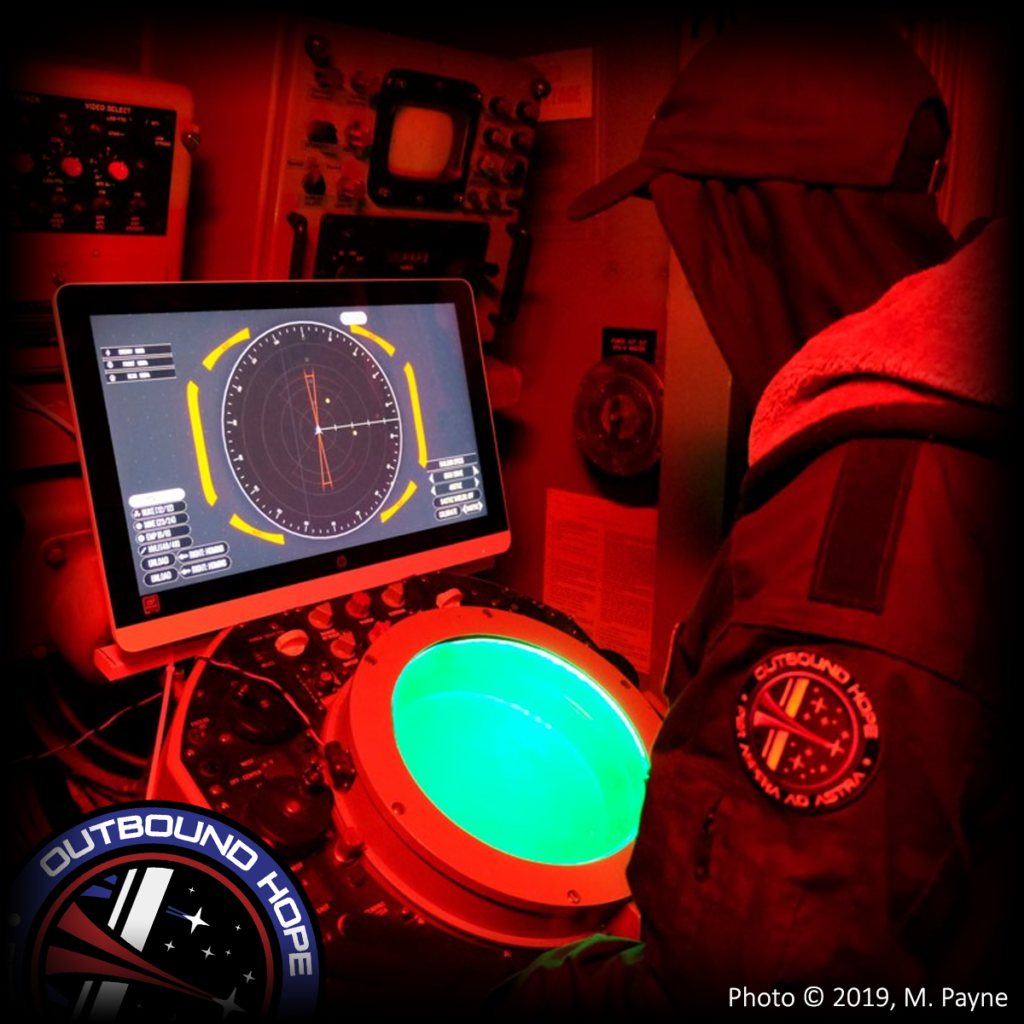
The medical staff utilized several key props in their role including the BioBed and the Handheld Augmented Diagnostic & Treatment Unit (HADTU) unit. The BioBed was a device that players would use to ‘download’ their consciousness every 12 hours during play. In the event a player was killed during the game their body could be repaired by the BioBed back to the time period of their last scan, but they would lose any crucial memories gained after that last scan to time of death. This led to very interesting roleplay dynamics and served to reduce player fears regarding possible character death in game.
The HADTU was a hand held electronic medical kit that could be used to instantly heal a player back up to full health in the event of physical, radiation or infection damage. Unfortunately, the number of units, and the charges available were limited and became a crucial ‘triage’ element of gameplay for the medical players.
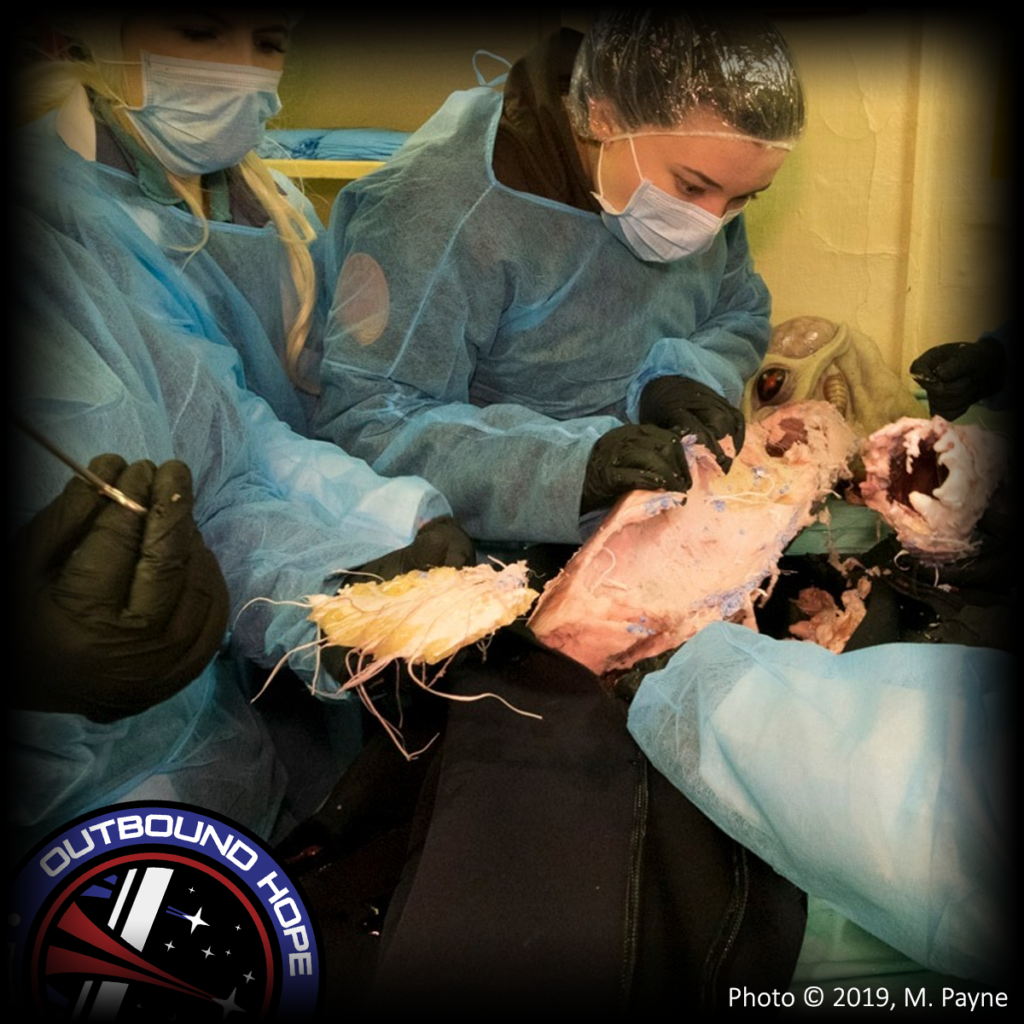
The science staff utilized various components given to them in game by the GM staff to solve real time puzzles or build more advanced technology that was then integrated into the game itself. A key ‘discovery’ by the scientists during our run was a modification to the BioBed that took the frequency of downloads from every 12 hours to every 6.
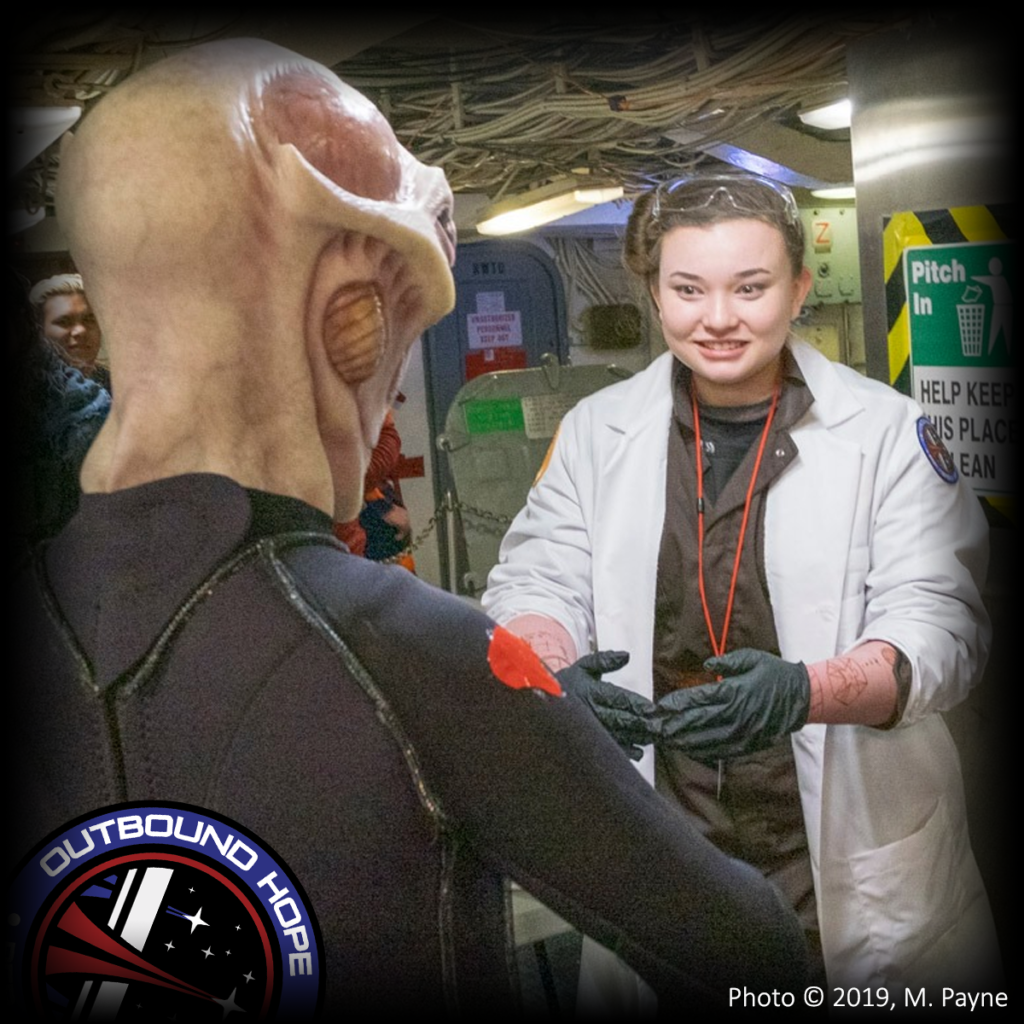
A final group that heavily relied on props for their duties were the marines and security personnel. They utilized extremely sophisticated laser tag weapons designed by Battlefield Sports and rented from Mid-Michigan Laser Combat for the duration of the game. These weapons not only looked real but added an air of authenticity to the live fire combat play and were essential to the marine and security character experience.
Combat Systems
There were three distinct forms of combat used to resolve in game conflict including ship to ship combat, live fire combat and passive combat. Ship to ship combat was conducted on the bridge by the command staff and crew and utilized the computer software to operate the ship’s weapon systems. The crew oversaw the maneuvering the ship through space while firing guns, missiles and nukes to destroy enemy hostiles.
Live fire combat was done primarily by the marine and security contingent on the ship and utilized the laser tag weapon systems. Live fire situations aboard the Edson were limited to certain areas of the ship to prevent damaging the museum ship and were always announced over the ship intercom prior to the start of any combat.
This was not only for safety, but also allowed those players not interested in live fire combat, the opportunity to clear the area prior to the first shots being fired. Live fire combat also took place off the Edson.
Quest rented out space at a nearby laser tag facility and players were shuttled there during the game to utilize their play space. This was done under the guise of the marines conducting a boarding raid on a prison ship whose inmates had rioted and had taken over that ship. Once the riot had been stifled, the marines were driven back to the ship and were able to report back to the command staff on their actions.
Passive combat was designed to deal with the constraints of combat in areas of the ship where live fire weapons and maneuvering simply wasn’t safe, could damage the ship, or occurred between players not typically involved in combat roles. Passive combat was taught and practiced during the pre-game workshops and played an essential role in conflict negotiations between the more non-combative roles such as those in civilian government and the command staff.
Passive combat situations are always initiated by an ‘Aggressor’ player calling ACTION and actively brandishing a weapon or tool at another player. This would cause all players in the vicinity to freeze and begin a sort of turn-based response to the threat. Players would have a five second call to declare an action (AVOID, DRAW, PROTECT, BANG, STAB, or SHIELD). Combat progressed in a series of rounds until all players in the conflict were either ‘suppressed’ or taken as a ‘hostage.’
While initially confusing, passive combat played out in a very organized fashion in the few situations it was needed, and the GM staff was always near at hand in the event they needed to serve as mediators during a round. It was a very well-designed system to deal with the limitations of being on a museum ship and allowed avenues of game play that otherwise would not have been possible.
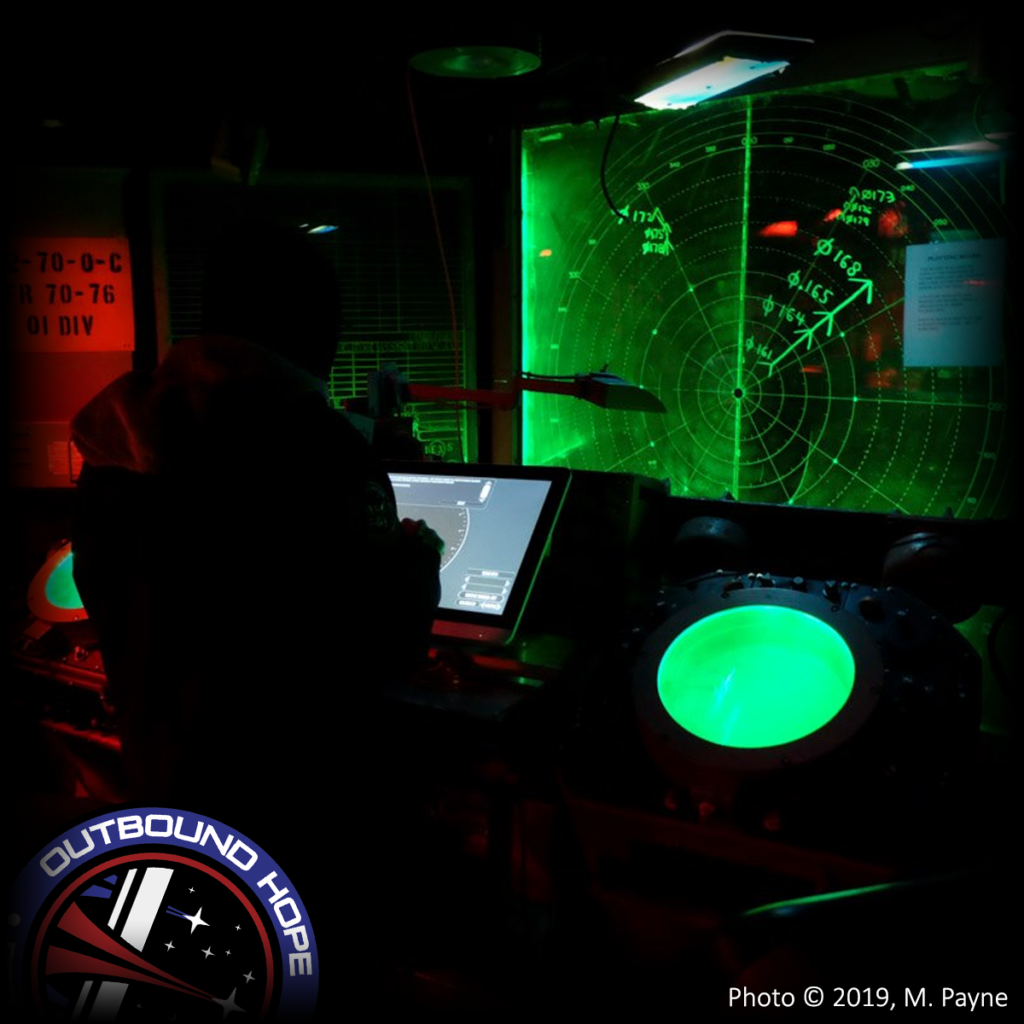
Safety Mechanics
Prior to the start of game, the World Document was released so that everyone would be familiar with safety and consent mechanics. These mechanics were then reiterated during the workshop session and were very similar in tone to those of many LARPs that I have attended, with the primary focus being on the player’s safety and mental wellbeing before that of a character or game. There was also an out of game space on the ship where a player could go to decompress for a moment, talk with GM staff, or warm up as the need arose.
During game the GM staff freely mingled with the players. They were dressed in bright orange and blue jumpsuits and were referred to as ‘Space Janitors.’ Players were told to ignore them unless clarification was needed. In the event that gameplay or interactions became uncomfortable or threatening to a player’s physical or mental well-being, they could use the call out of “Clean Up.” The scene would immediately pause and out of character scene negotiation would begin. More often than not, players were able to resolve or mediate any issues that had arisen, and the scene would resume, this time taking into account the negotiated boundaries or desires.
However, if mediation was not successful, or the situation was dire and a player needed to remove themselves from game play immediately, a Space Janitor would be near at hand to assist with the scene ‘Clean Up’ as needed. As the title implied, that was what the Janitors were there for, to help clean up messes as needed.
Gameplay
I have been to several blockbuster LARPS where players come together prior to the game and organize various scenes and plot that they want to see unfold within a game and then act it out accordingly, often with the assistance of a GM staff. This style of play can be very rewarding and allow you to tell a very specific story, but it tends to be stifling to elements of surprise or outside conflict as everything is known prior to the start of game.
That was not the case for Outbound Hope, and it was refreshing to play what I call a ‘reactive’ style of LARP for a change of pace. To me, reactive gameplay is when characters are continuously faced with external threats and challenges provided by the storytelling team and must come up with solutions in collaboration with other players to meet those challenges. Those solutions may not always be the most efficient or even successful, but to know your decisions carry weight and consequences in moving the story forward, added a sense of authenticity to the game that was very near to life.
Early on in game play a terrorist organization known as the Anti Colonial Alliance snuck members onto our ship, with the intent of sabotaging the mission and either taking members of the government hostage or killing them. It was up to the Marine and Security contingents to defeat these terrorists and protect the ship. While the overall defense was a success, several Marine players did die during the engagement and needed to be revived with the BioBed. Had a single terrorist gotten through, the story could have gone very differently.
On the other hand, there was a situation in the CIC in which we were engaged in ship to ship combat with a hostile enemy fleet. Our gunner had fired a nuclear missile at one of the alien ships, but had misjudged their speed and maneuverability and ended up hitting one of our own civilian vessels, destroying it instantly. Dealing with the internal guilt of killing the 2,000 people on that ship and knowing their actions did not have a ‘do-over’ provided extremely intense play for that player.
Utilizing reactive play had the added benefit of making some of the emotions a player felt in response to their character’s actions more powerful and fulfilling. You as the player knew that you had successfully solved a puzzle, had stopped an epidemic, had learned the best way to communicate with an alien race, and you could take pride that you made the story and the mission better.
New Players and Accessibility
Something that was extremely encouraging to learn during my run, was that at least a third of our player base, and several members of the storyteller staff, had never LARPed before. Based upon the quality of their roleplay I was amazed to learn that they were not veteran LARPers. The game is extremely welcoming to new players and we have a very active Discord channel and Facebook to answer any questions new players might have, and to interact with each other between game so we can get to know each other as people, not just our characters.
There are however, several considerations that need to be made when looking at a game such as Outbound Hope. The game is played on a decommissioned battleship, and as such, there are significant limitations for people who have mobility issues. There were often raised bulkheads that needed to be stepped over before one could access certain locations on the ship and numerous steep stair-ladders that needed to be traversed to maneuver between the various decks. Another was the elements. We were playing in Michigan, on the lake, in November, on a metal boat. While temperatures are usually in the low 40s during this time of year, an unexpected cold front had come in just prior to game on, and chilled us into the 20s. The ship itself does not have heating capabilities, besides the numerous space heaters that were brought in for use during the game. It was extremely cold, and even knowing that, and being prepared with numerous layers, gloves and handwarmers, this may not be the right game for someone who is extremely sensitive to the cold.
While the mission was initially intended to have players sleep on the ship in crew berthing, many players elected to overnight at the nearby Quality Inn where they had access to warm showers and nice beds. Shuttles were provided to take players back and forth from the hotel to the ship and staying at the hotel did not in any way negatively impact the player experience.
What Comes Next
On December 15, 2019 general enlistment will open for Outbound Hope, Season II: Lost Hope, which will take place over November 6-8, 2020 and November 13-15, 2020 aboard the U.S.S. Edson. The only significant changes to enlistment from last year is that hotel lodging is now included with the ticket price, and several new character roles are available for enlistment. While players may still elect to sleep at night on the ship if desired, the vast majority of players and staff will be at the hotel. Tickets can be purchased in full, or payment options are available in installments up through August.
The staff at Quest plan to continue the tradition of World Build Wednesdays every week until launch next November. The WBW will serve as a window into the events that are occurring on The Ascendant Dawn and the remaining ships in the Colonial Fleet in real-time as we draw close to season two. The first WBW, detailing the events of Season I can be found at https://outboundhope.com, as can information on enlistment.
Until next year, Per Aspera Ad Astra!